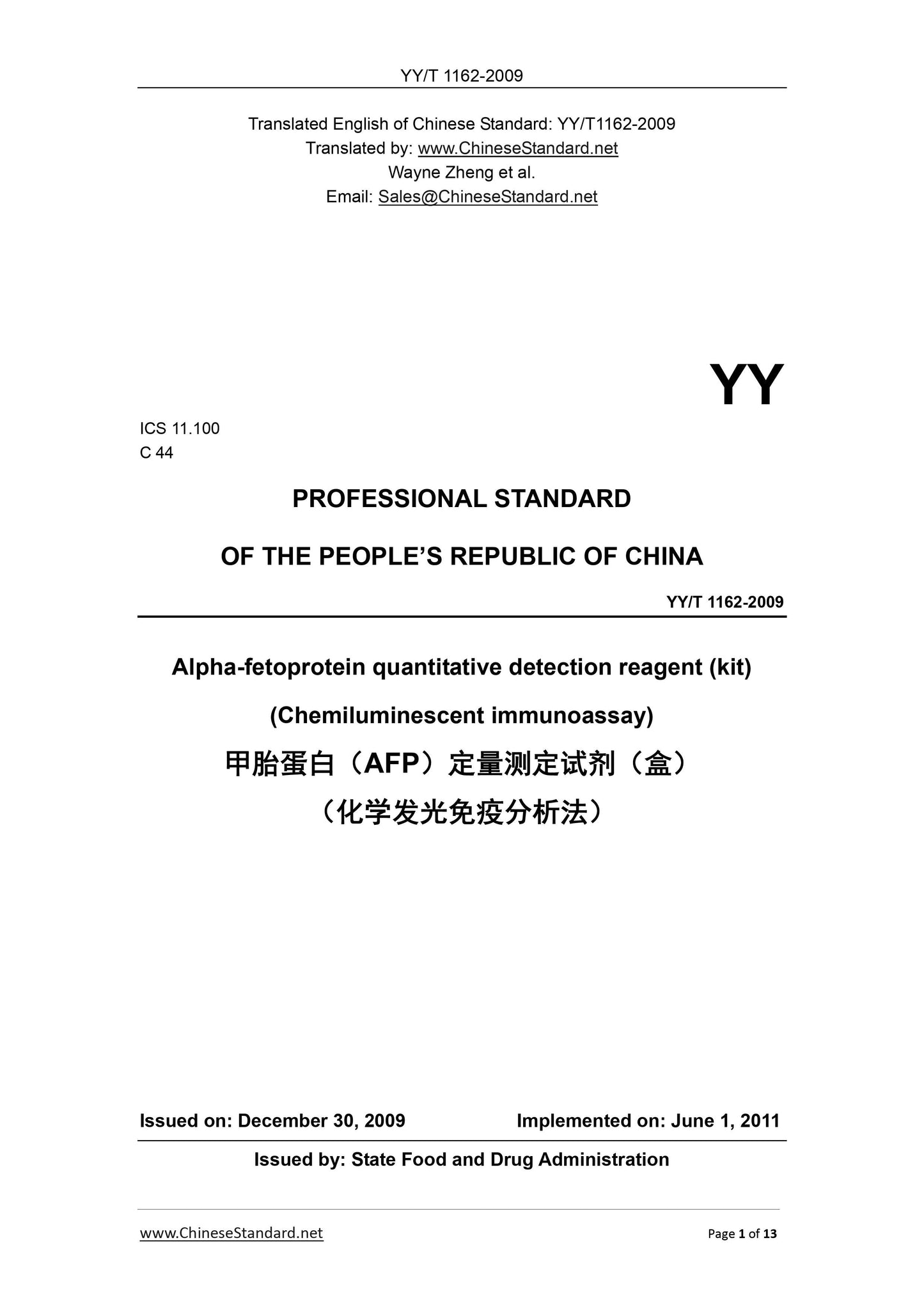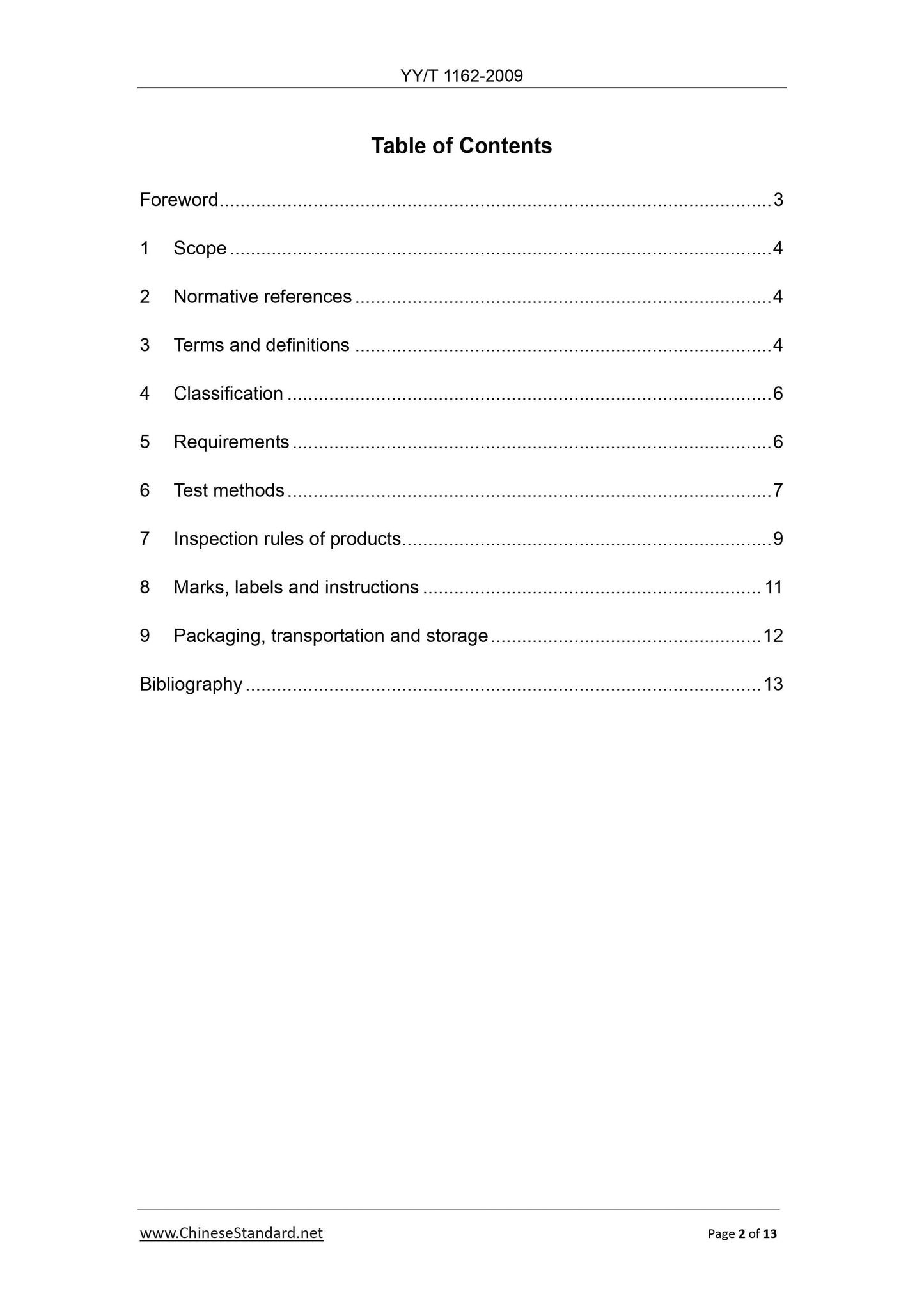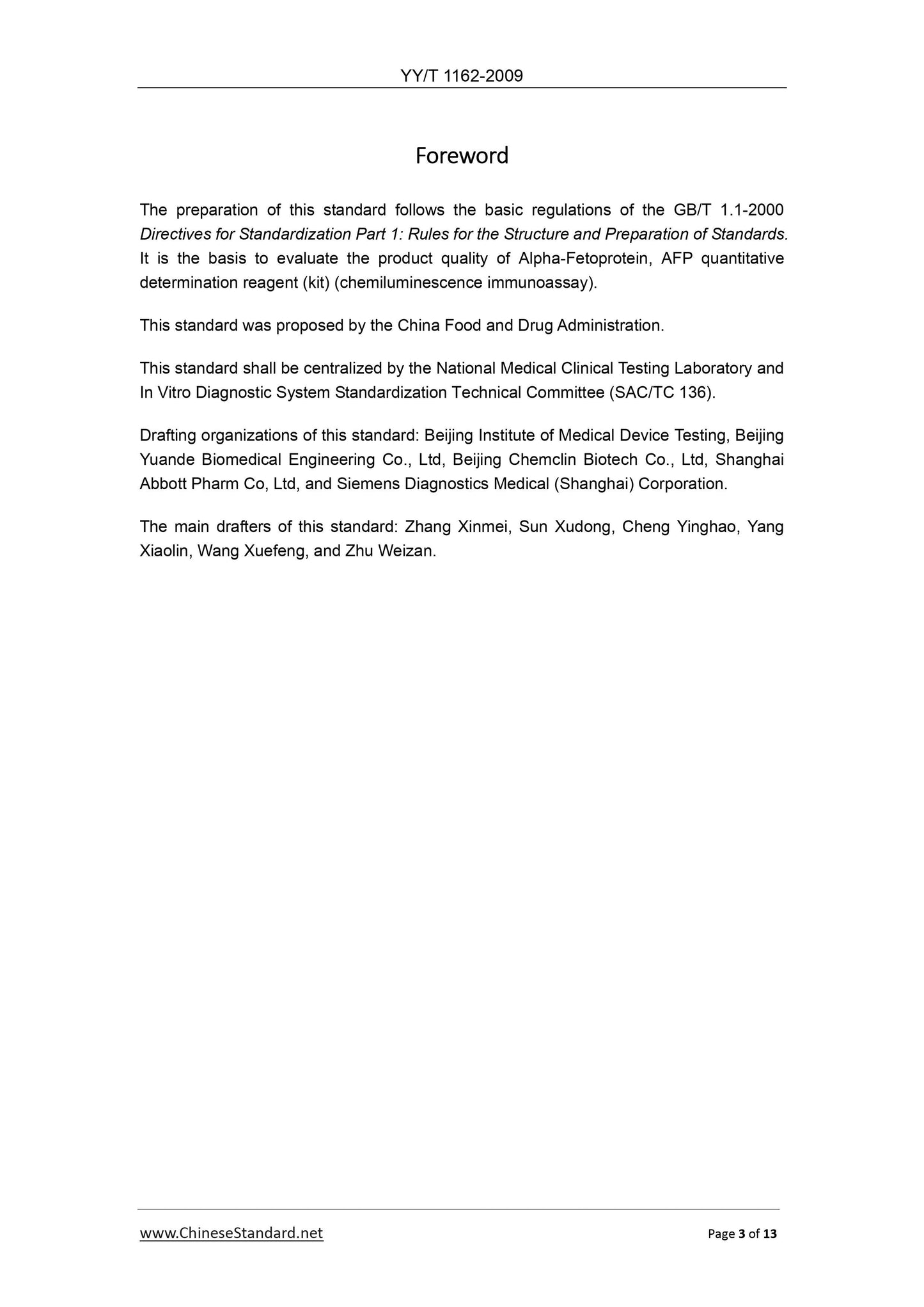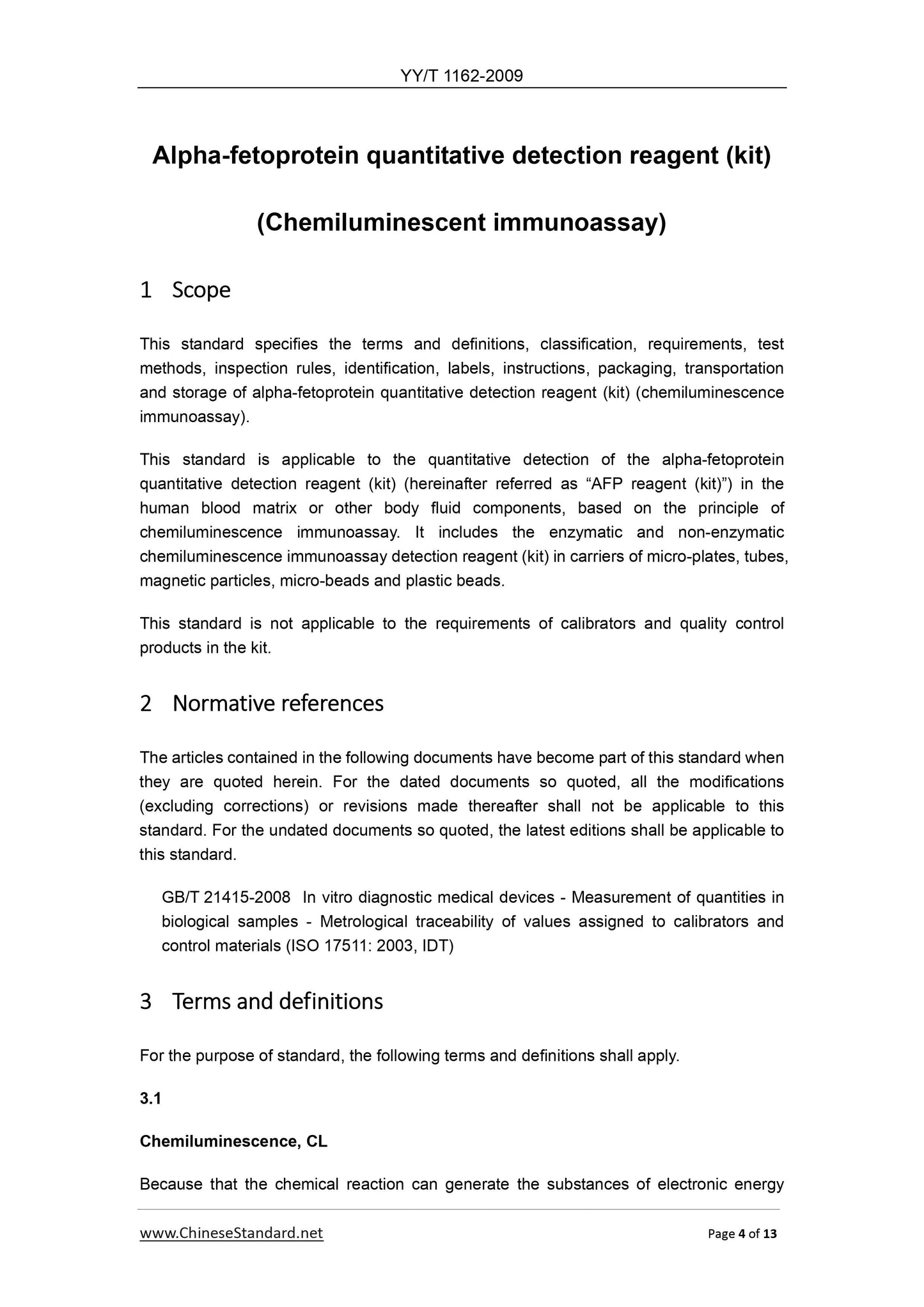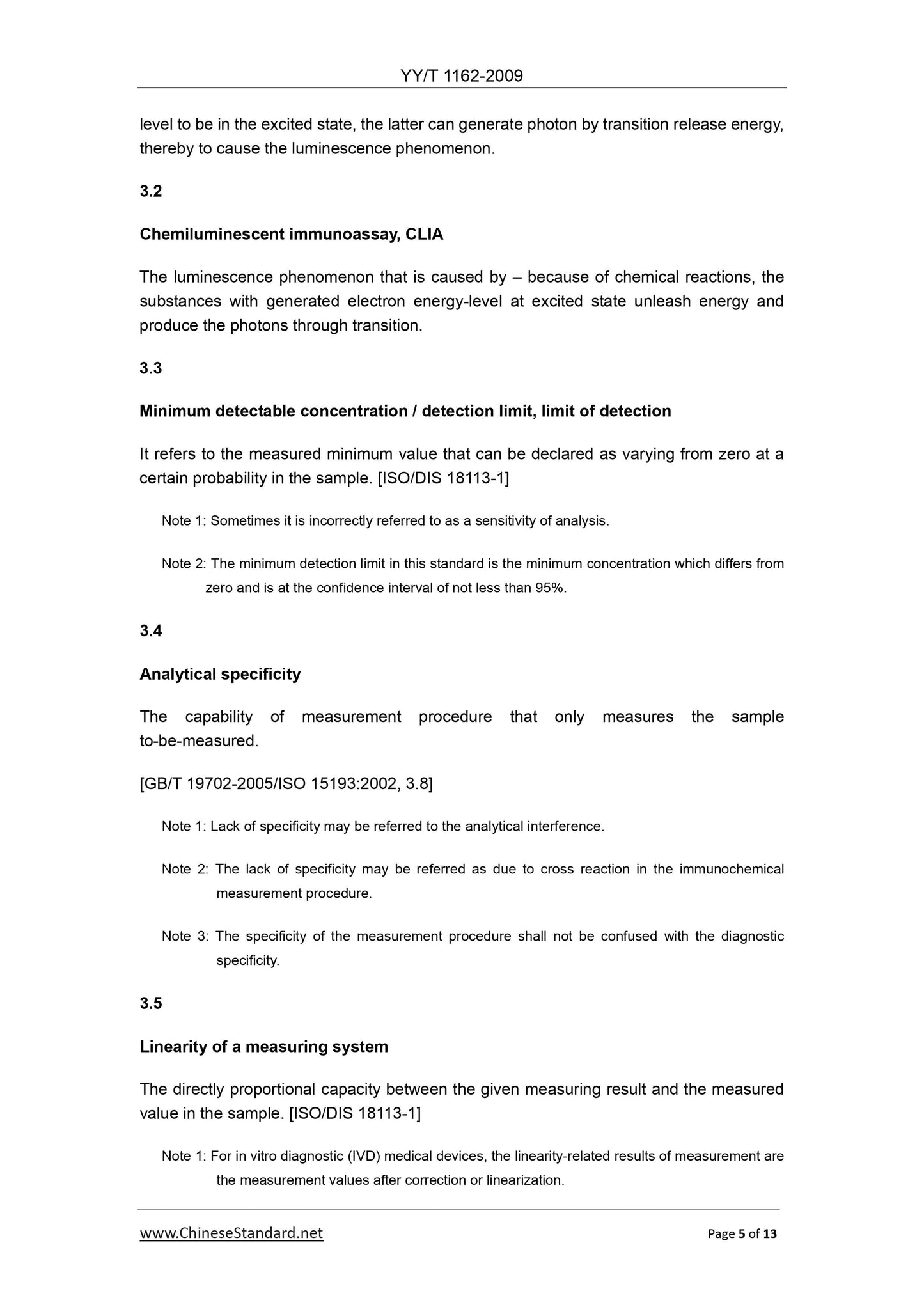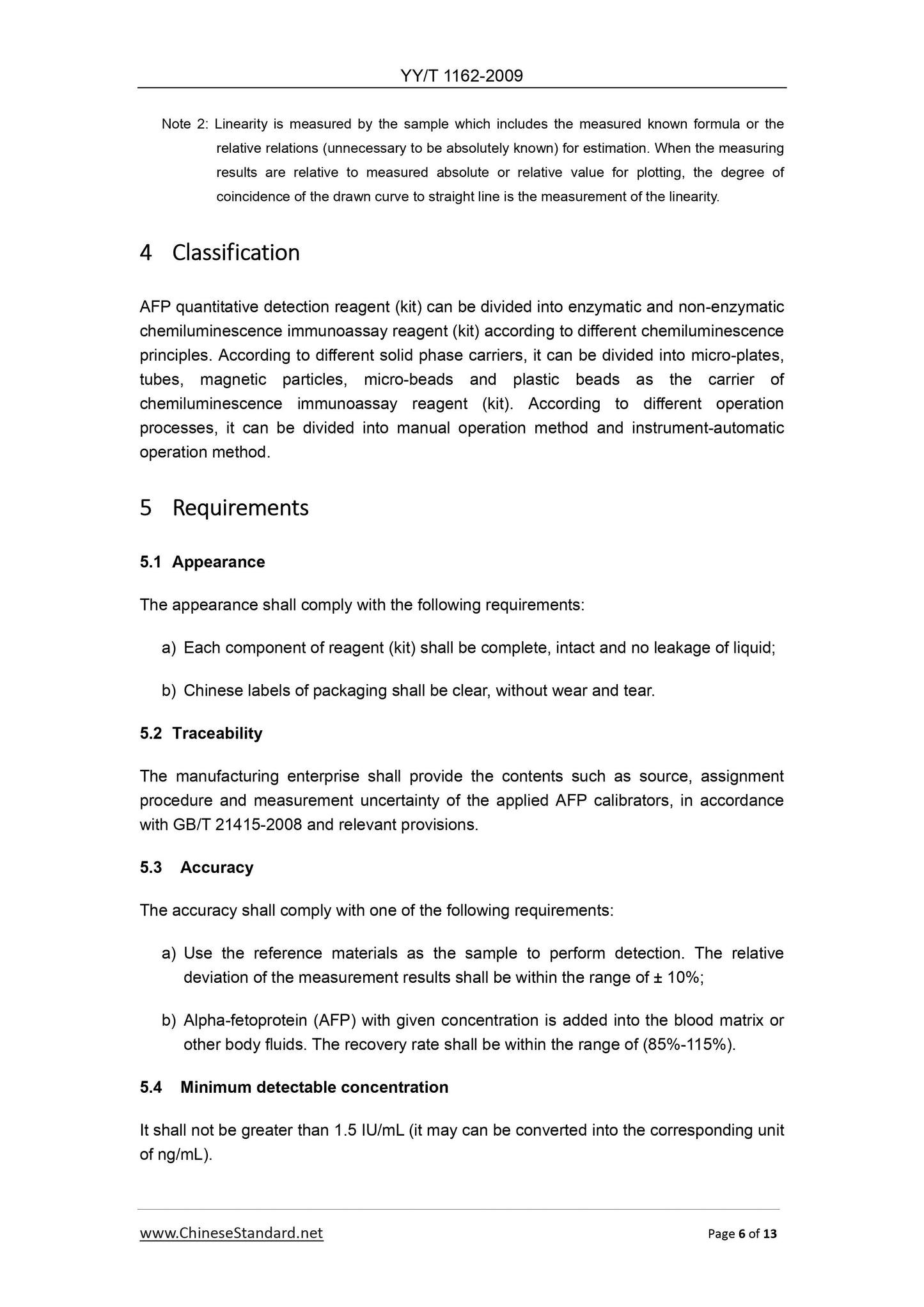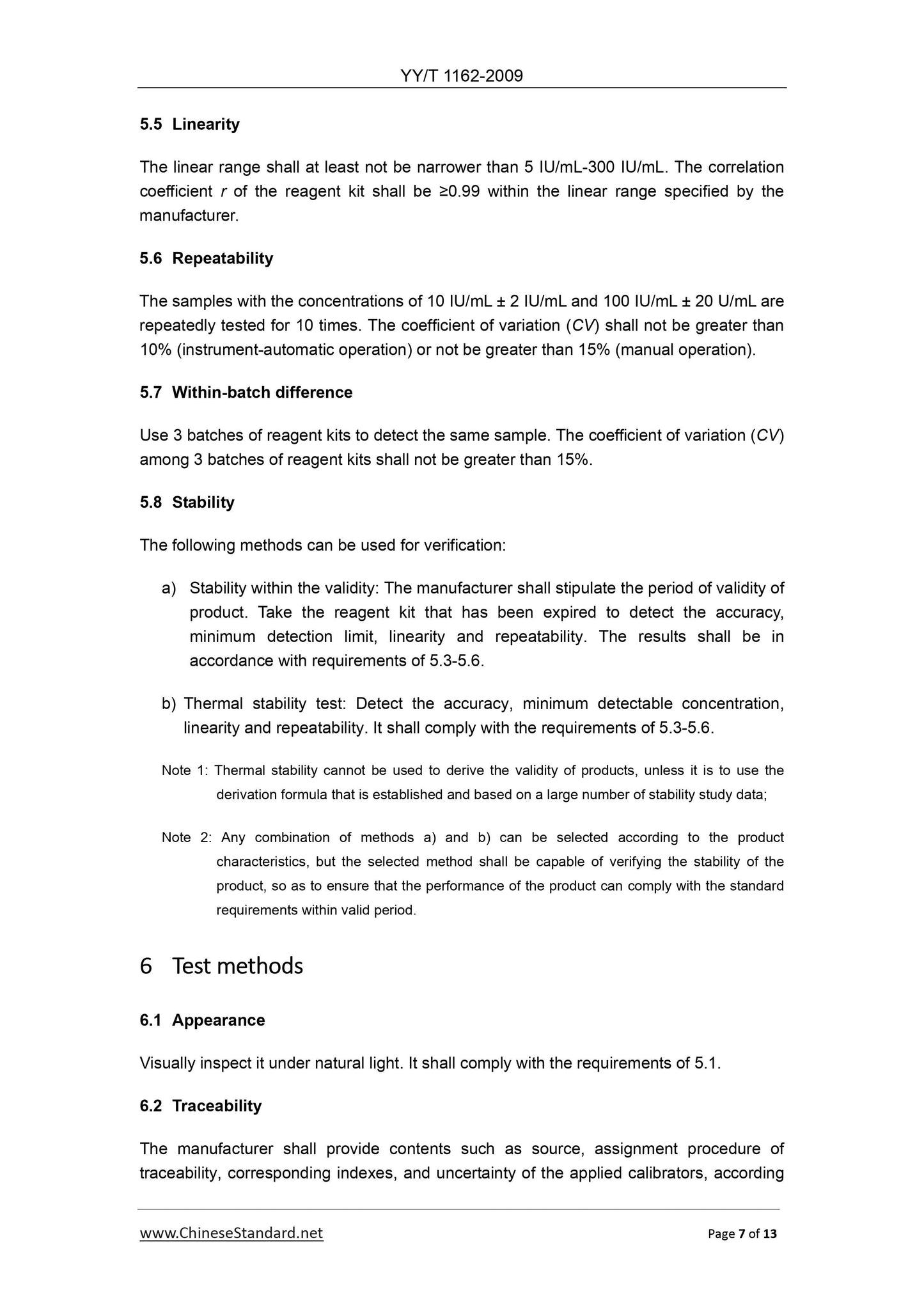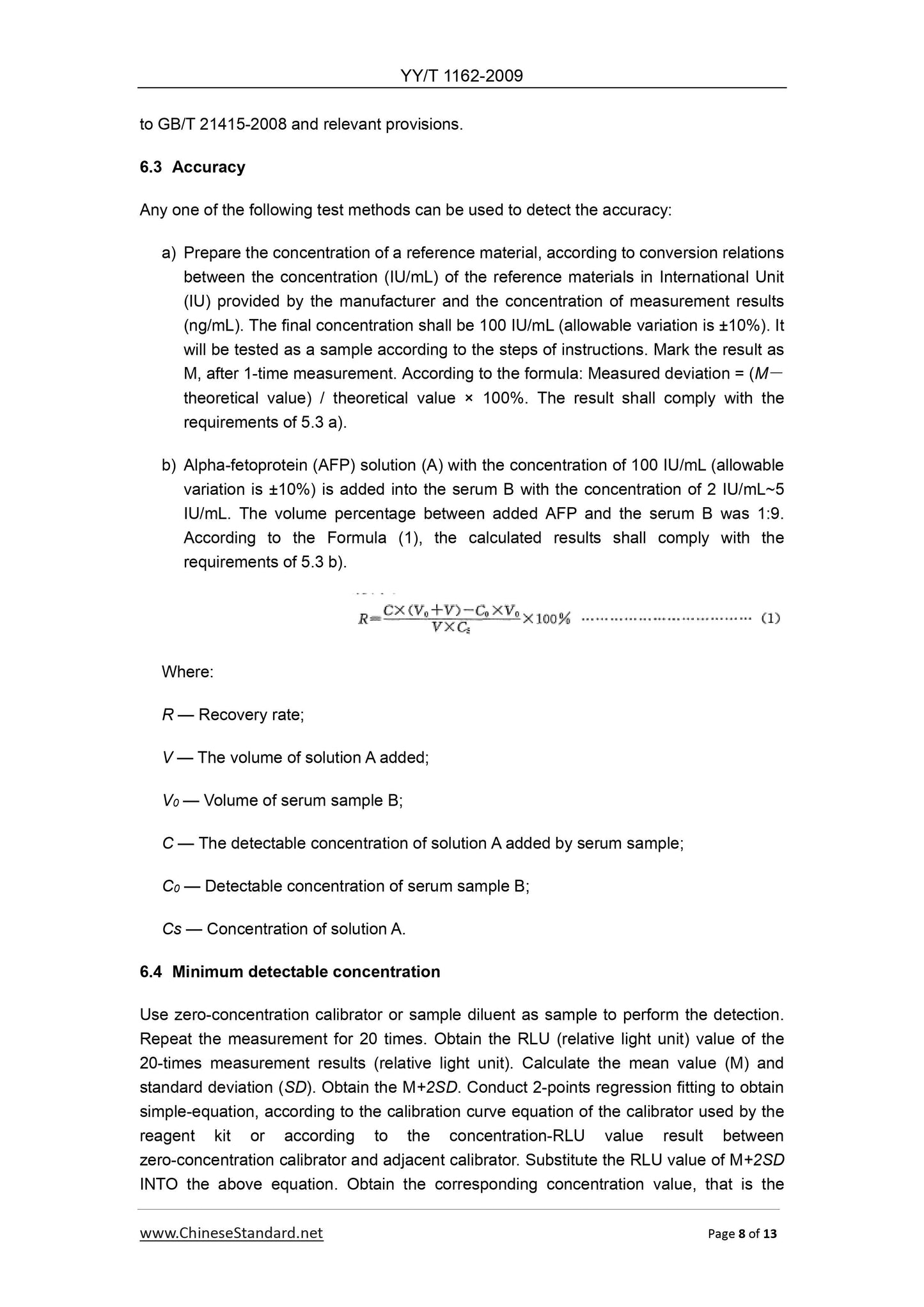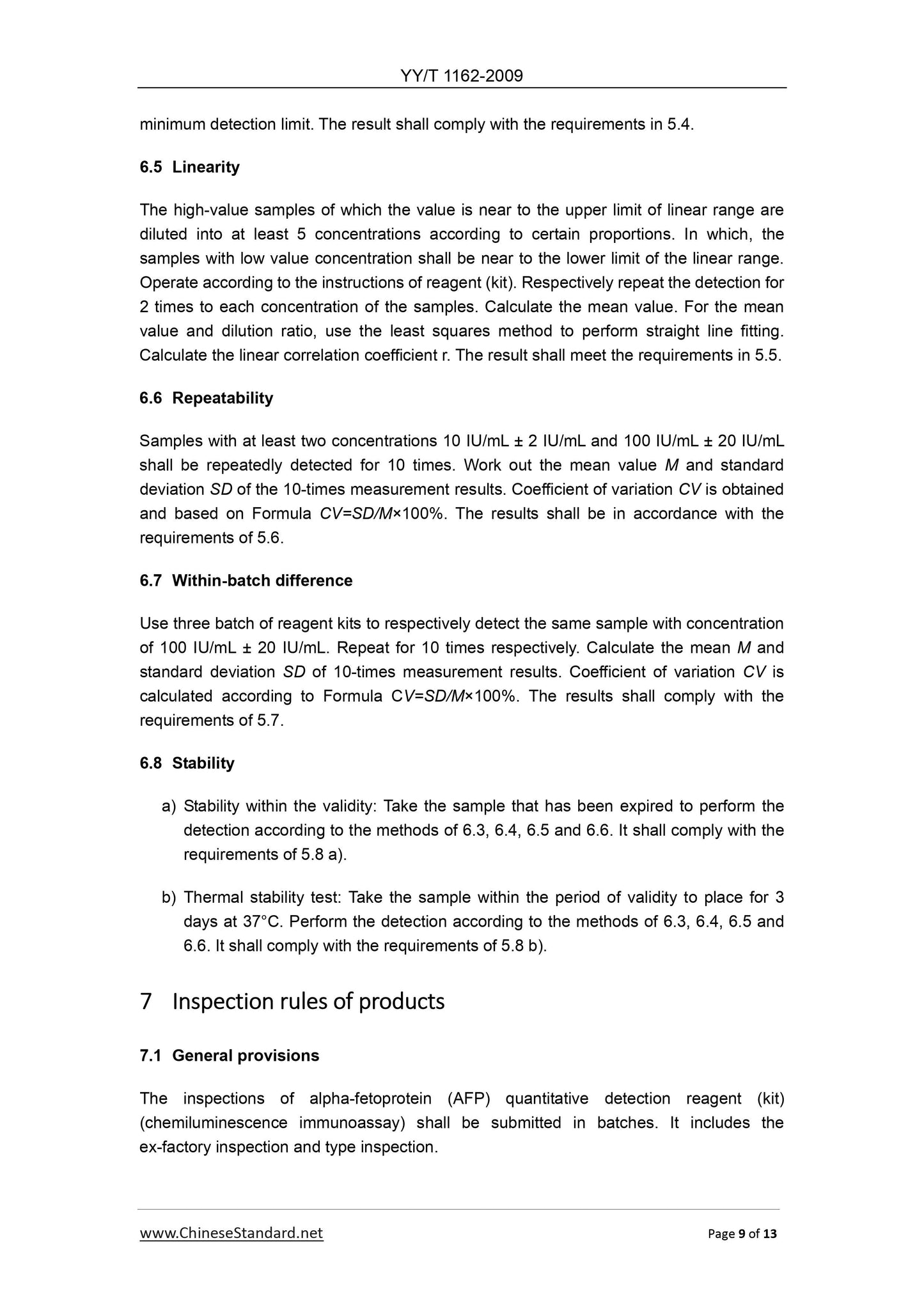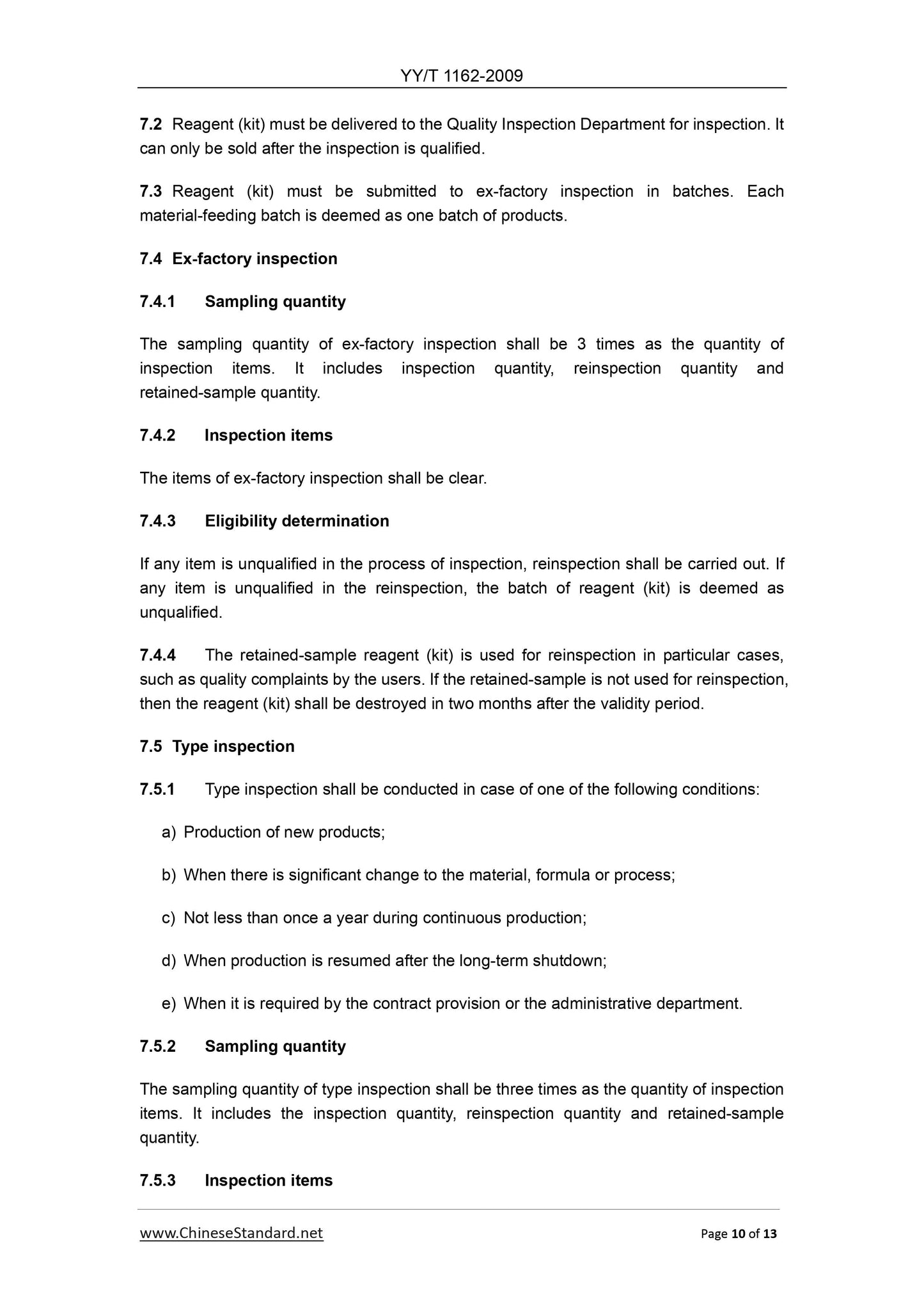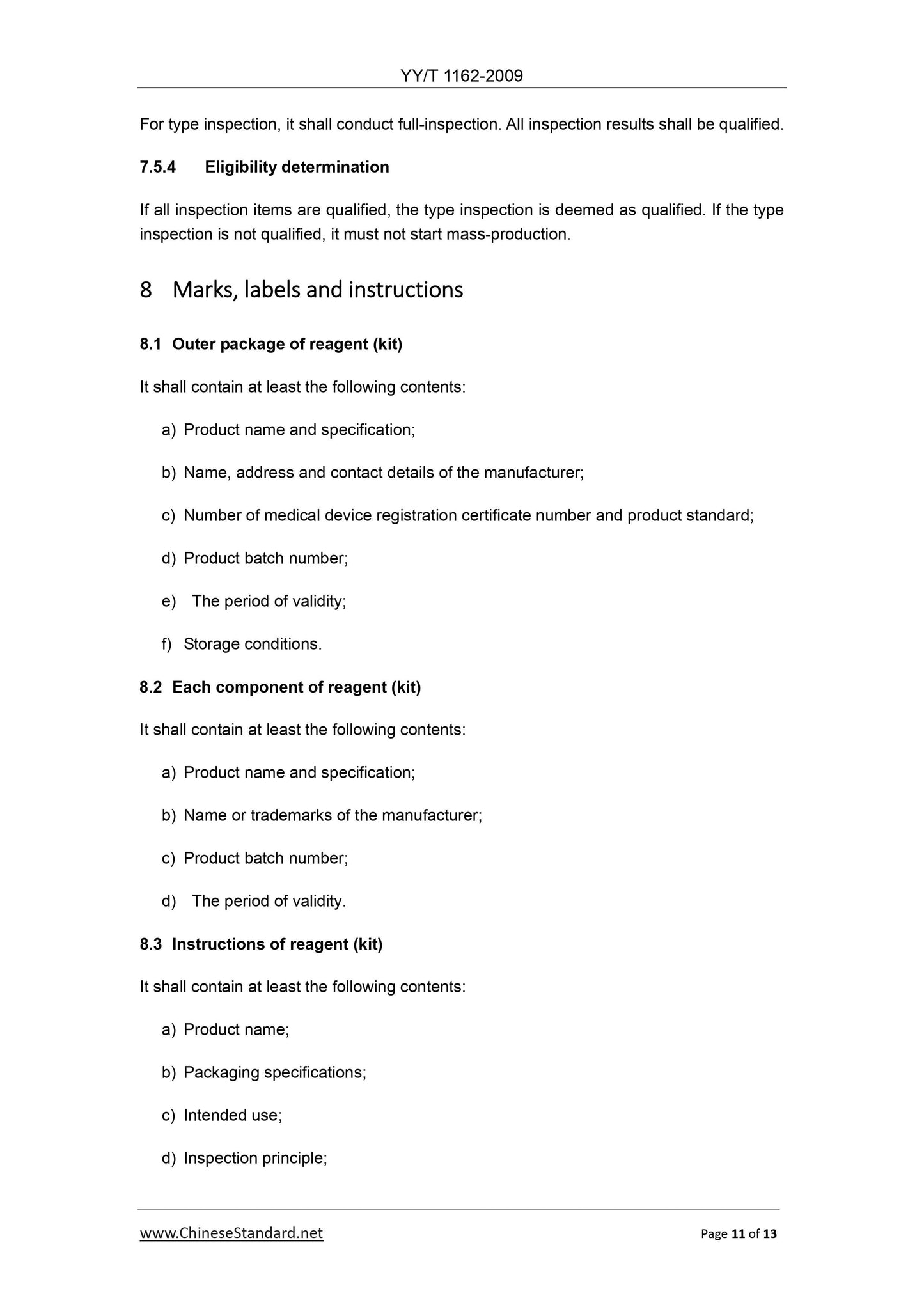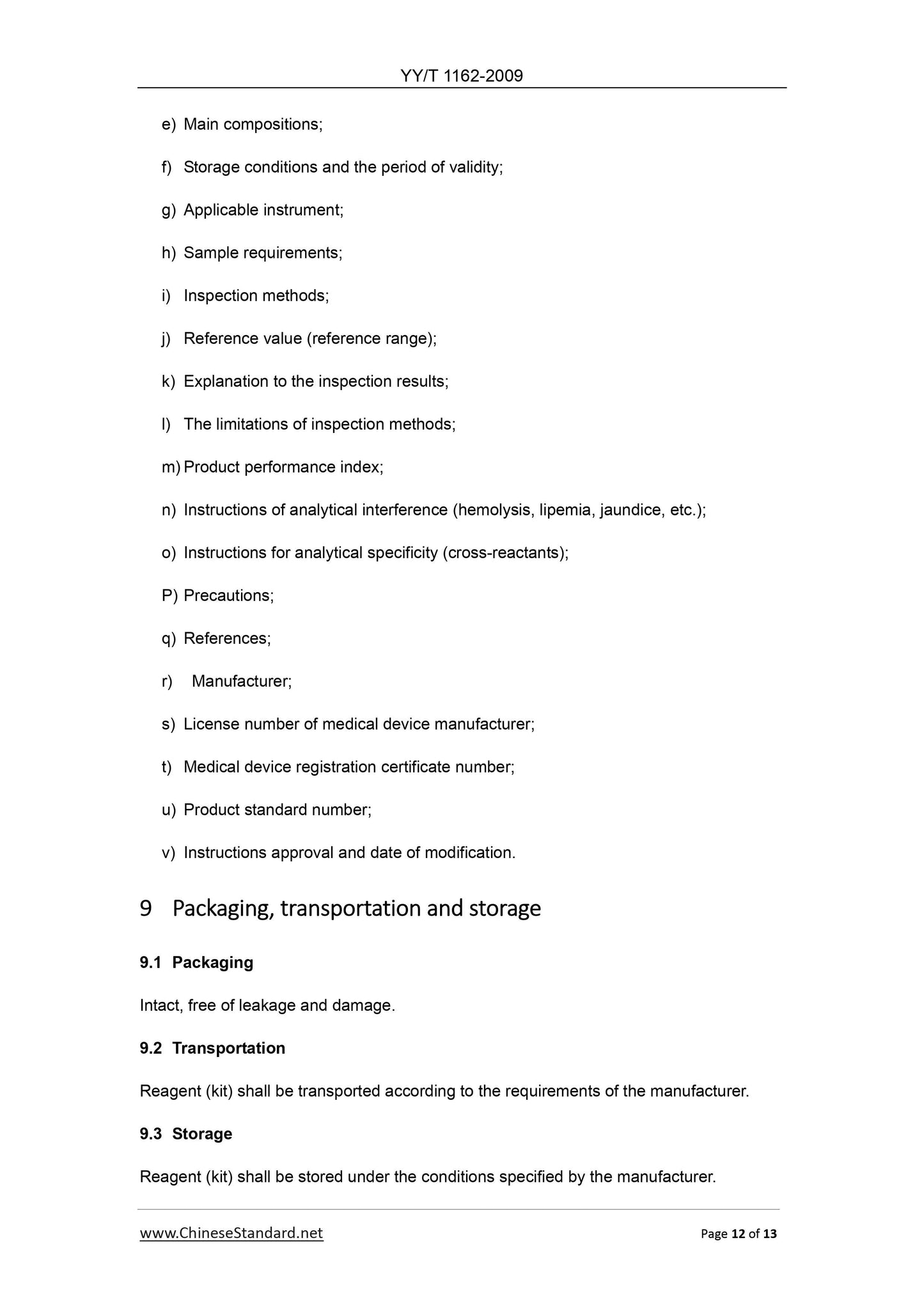1
/
의
12
PayPal, credit cards. Download editable-PDF & invoice in 1 second!
YY/T 1162-2009 English PDF (YYT1162-2009)
YY/T 1162-2009 English PDF (YYT1162-2009)
정가
$140.00 USD
정가
할인가
$140.00 USD
단가
/
단위
배송료는 결제 시 계산됩니다.
픽업 사용 가능 여부를 로드할 수 없습니다.
Delivery: 3 seconds. Download true-PDF + Invoice.
Get QUOTATION in 1-minute: Click YY/T 1162-2009
Historical versions: YY/T 1162-2009
Preview True-PDF (Reload/Scroll if blank)
YY/T 1162-2009: Alpha-fetoprotein quantitative detection reagent (kit) (Chemiluminescent immunoassay)
YY/T 1162-2009
YY
ICS 11.100
C 44
PROFESSIONAL STANDARD
OF THE PEOPLE’S REPUBLIC OF CHINA
Alpha-fetoprotein quantitative detection reagent (kit)
(Chemiluminescent immunoassay)
ISSUED ON. DECEMBER 30, 2009
IMPLEMENTED ON. JUNE 1, 2011
Issued by. State Food and Drug Administration
Table of Contents
Foreword ... 3
1 Scope ... 4
2 Normative references ... 4
3 Terms and definitions ... 4
4 Classification ... 6
5 Requirements ... 6
6 Test methods ... 7
7 Inspection rules of products ... 9
8 Marks, labels and instructions ... 11
9 Packaging, transportation and storage ... 12
Bibliography ... 13
Foreword
The preparation of this standard follows the basic regulations of the GB/T 1.1-2000
Directives for Standardization Part 1. Rules for the Structure and Preparation of Standards.
It is the basis to evaluate the product quality of Alpha-Fetoprotein, AFP quantitative
determination reagent (kit) (chemiluminescence immunoassay).
This standard was proposed by the China Food and Drug Administration.
This standard shall be centralized by the National Medical Clinical Testing Laboratory and
In Vitro Diagnostic System Standardization Technical Committee (SAC/TC 136).
Drafting organizations of this standard. Beijing Institute of Medical Device Testing, Beijing
Yuande Biomedical Engineering Co., Ltd, Beijing Chemclin Biotech Co., Ltd, Shanghai
Abbott Pharm Co, Ltd, and Siemens Diagnostics Medical (Shanghai) Corporation.
The main drafters of this standard. Zhang Xinmei, Sun Xudong, Cheng Yinghao, Yang
Xiaolin, Wang Xuefeng, and Zhu Weizan.
Alpha-fetoprotein quantitative detection reagent (kit)
(Chemiluminescent immunoassay)
1 Scope
This standard specifies the terms and definitions, classification, requirements, test
methods, inspection rules, identification, labels, instructions, packaging, transportation
and storage of alpha-fetoprotein quantitative detection reagent (kit) (chemiluminescence
immunoassay).
This standard is applicable to the quantitative detection of the alpha-fetoprotein
quantitative detection reagent (kit) (hereinafter referred as “AFP reagent (kit)”) in the
human blood matrix or other body fluid components, based on the principle of
chemiluminescence immunoassay. It includes the enzymatic and non-enzymatic
chemiluminescence immunoassay detection reagent (kit) in carriers of micro-plates, tubes,
magnetic particles, micro-beads and plastic beads.
This standard is not applicable to the requirements of calibrators and quality control
products in the kit.
2 Normative references
The articles contained in the following documents have become part of this standard when
they are quoted herein. For the dated documents so quoted, all the modifications
(excluding corrections) or revisions made thereafter shall not be applicable to this
standard. For the undated documents so quoted, the latest editions shall be applicable to
this standard.
GB/T 21415-2008 In vitro diagnostic medical devices - Measurement of quantities in
biological samples - Metrological traceability of values assigned to calibrators and
control materials (ISO 17511. 2003, IDT)
3 Terms and definitions
For the purpose of standard, the following terms and definitions shall apply.
3.1
Chemiluminescence, CL
Because that the chemical reaction can generate the substances of electronic energy
level to be in the excited state, the latter can generate photon by transition release energy,
thereby to cause the luminescence phenomenon.
3.2
Chemiluminescent immunoassay, CLIA
The luminescence phenomenon that is caused by – because of chemical reactions, the
substances with generated electron energy-level at excited state unleash energy and
produce the photons through transition.
3.3
Minimum detectable concentration / detection limit, limit of detection
It refers to the measured minimum value that can be declared as varying from zero at a
certain probability in the sample. [ISO/DIS 18113-1]
Note 1. Sometimes it is incorrectly referred to as a sensitivity of analysis.
Note 2. The minimum detection limit in this standard is the minimum concentration which differs from
zero and is at the confidence interval of not less than 95%.
3.4
Analytical specificity
The capability of measurement procedure that only measures the sample
to-be-measured.
[GB/T 19702-2005/ISO 15193.2002, 3.8]
Note 1. Lack of specificity may be referred to the analytical interference.
Note 2. The lack of specificity may be referred as due to cross reaction in the immunochemical
measurement procedure.
Note 3. The specificity of the measurement procedure shall not be confused with the diagnostic
specificity.
3.5
Linearity of a measuring system
The directly proportional capacity between the given measuring result and the measured
value in the sample. [ISO/DIS 18113-1]
Note 1. For in vitro diagnostic (IVD) medical devices, the linearity-related results of measurement are
the measurement values after correction or linearization.
minimum detection limit. The result shall comply with the requirements in 5.4.
6.5 Linearity
The high-value samples of which the value is near to the upper limit of linear range are
diluted into at least 5 concentrations according to certain proportions. In which, the
samples with low value concentration shall be near to the lower limit of the linear range.
Operate according to the instructions of reagent (kit). Respectively repeat the detection for
2 times to each concentration of the samples. Calculate the mean value. For the mean
value and dilution ratio, use the least squares method to perform straight line fitting.
Calculate the linear correlation coefficient r. The result shall meet the requirements in 5.5.
6.6 Repeatability
Samples with at least two concentrations 10 IU/mL ± 2 IU/mL and 100 IU/mL ± 20 IU/mL
shall be repeatedly detected for 10 times. Work out the mean value M and standard
deviation SD of the 10-times measurement results. Coefficient of variation CV is obtained
and based on Formula CV=SD/M×100%. The results shall be in accordance with the
requirements of 5.6.
6.7 Within-batch difference
Use three batch of reagent kits to respectively detect the same sample with concentration
of 100 IU/mL ± 20 IU/mL. Repeat for 10 times respectively. Calculate the mean M and
standard deviation SD of 10-times measurement results. Coefficient of variation CV is
calculated according to Formula CV=SD/M×100%. The results shall comply with the
requirements of 5.7.
6.8 Stability
a) Stability within the validity. Take the sample that has been expired to perform the
detection according to the methods of 6.3, 6.4, 6.5 and 6.6. It shall comply with the
requirements of 5.8 a).
b) Thermal stability test. Take the sample within the period of validity to place for 3
days at 37°C. Perform the detection according to the methods of 6.3, 6.4, 6.5 and
6.6. It shall comply with the requirements of 5.8 b).
7 Inspection rules of products
7.1 General provisions
The inspections of alpha-fetoprotein (AFP) quantitative detection reagent (kit)
(chemiluminescence immunoassay) shall be submitted in batches. It includes the
ex-factory inspection and type inspection.
7.2 Reagent (kit) must be delivered to the Quality Inspection Department for inspection. It
can only be sold after the inspection is qualified.
7.3 Reagent (kit) must be submitted to ex-factory inspection in batches. Each
...
Get QUOTATION in 1-minute: Click YY/T 1162-2009
Historical versions: YY/T 1162-2009
Preview True-PDF (Reload/Scroll if blank)
YY/T 1162-2009: Alpha-fetoprotein quantitative detection reagent (kit) (Chemiluminescent immunoassay)
YY/T 1162-2009
YY
ICS 11.100
C 44
PROFESSIONAL STANDARD
OF THE PEOPLE’S REPUBLIC OF CHINA
Alpha-fetoprotein quantitative detection reagent (kit)
(Chemiluminescent immunoassay)
ISSUED ON. DECEMBER 30, 2009
IMPLEMENTED ON. JUNE 1, 2011
Issued by. State Food and Drug Administration
Table of Contents
Foreword ... 3
1 Scope ... 4
2 Normative references ... 4
3 Terms and definitions ... 4
4 Classification ... 6
5 Requirements ... 6
6 Test methods ... 7
7 Inspection rules of products ... 9
8 Marks, labels and instructions ... 11
9 Packaging, transportation and storage ... 12
Bibliography ... 13
Foreword
The preparation of this standard follows the basic regulations of the GB/T 1.1-2000
Directives for Standardization Part 1. Rules for the Structure and Preparation of Standards.
It is the basis to evaluate the product quality of Alpha-Fetoprotein, AFP quantitative
determination reagent (kit) (chemiluminescence immunoassay).
This standard was proposed by the China Food and Drug Administration.
This standard shall be centralized by the National Medical Clinical Testing Laboratory and
In Vitro Diagnostic System Standardization Technical Committee (SAC/TC 136).
Drafting organizations of this standard. Beijing Institute of Medical Device Testing, Beijing
Yuande Biomedical Engineering Co., Ltd, Beijing Chemclin Biotech Co., Ltd, Shanghai
Abbott Pharm Co, Ltd, and Siemens Diagnostics Medical (Shanghai) Corporation.
The main drafters of this standard. Zhang Xinmei, Sun Xudong, Cheng Yinghao, Yang
Xiaolin, Wang Xuefeng, and Zhu Weizan.
Alpha-fetoprotein quantitative detection reagent (kit)
(Chemiluminescent immunoassay)
1 Scope
This standard specifies the terms and definitions, classification, requirements, test
methods, inspection rules, identification, labels, instructions, packaging, transportation
and storage of alpha-fetoprotein quantitative detection reagent (kit) (chemiluminescence
immunoassay).
This standard is applicable to the quantitative detection of the alpha-fetoprotein
quantitative detection reagent (kit) (hereinafter referred as “AFP reagent (kit)”) in the
human blood matrix or other body fluid components, based on the principle of
chemiluminescence immunoassay. It includes the enzymatic and non-enzymatic
chemiluminescence immunoassay detection reagent (kit) in carriers of micro-plates, tubes,
magnetic particles, micro-beads and plastic beads.
This standard is not applicable to the requirements of calibrators and quality control
products in the kit.
2 Normative references
The articles contained in the following documents have become part of this standard when
they are quoted herein. For the dated documents so quoted, all the modifications
(excluding corrections) or revisions made thereafter shall not be applicable to this
standard. For the undated documents so quoted, the latest editions shall be applicable to
this standard.
GB/T 21415-2008 In vitro diagnostic medical devices - Measurement of quantities in
biological samples - Metrological traceability of values assigned to calibrators and
control materials (ISO 17511. 2003, IDT)
3 Terms and definitions
For the purpose of standard, the following terms and definitions shall apply.
3.1
Chemiluminescence, CL
Because that the chemical reaction can generate the substances of electronic energy
level to be in the excited state, the latter can generate photon by transition release energy,
thereby to cause the luminescence phenomenon.
3.2
Chemiluminescent immunoassay, CLIA
The luminescence phenomenon that is caused by – because of chemical reactions, the
substances with generated electron energy-level at excited state unleash energy and
produce the photons through transition.
3.3
Minimum detectable concentration / detection limit, limit of detection
It refers to the measured minimum value that can be declared as varying from zero at a
certain probability in the sample. [ISO/DIS 18113-1]
Note 1. Sometimes it is incorrectly referred to as a sensitivity of analysis.
Note 2. The minimum detection limit in this standard is the minimum concentration which differs from
zero and is at the confidence interval of not less than 95%.
3.4
Analytical specificity
The capability of measurement procedure that only measures the sample
to-be-measured.
[GB/T 19702-2005/ISO 15193.2002, 3.8]
Note 1. Lack of specificity may be referred to the analytical interference.
Note 2. The lack of specificity may be referred as due to cross reaction in the immunochemical
measurement procedure.
Note 3. The specificity of the measurement procedure shall not be confused with the diagnostic
specificity.
3.5
Linearity of a measuring system
The directly proportional capacity between the given measuring result and the measured
value in the sample. [ISO/DIS 18113-1]
Note 1. For in vitro diagnostic (IVD) medical devices, the linearity-related results of measurement are
the measurement values after correction or linearization.
minimum detection limit. The result shall comply with the requirements in 5.4.
6.5 Linearity
The high-value samples of which the value is near to the upper limit of linear range are
diluted into at least 5 concentrations according to certain proportions. In which, the
samples with low value concentration shall be near to the lower limit of the linear range.
Operate according to the instructions of reagent (kit). Respectively repeat the detection for
2 times to each concentration of the samples. Calculate the mean value. For the mean
value and dilution ratio, use the least squares method to perform straight line fitting.
Calculate the linear correlation coefficient r. The result shall meet the requirements in 5.5.
6.6 Repeatability
Samples with at least two concentrations 10 IU/mL ± 2 IU/mL and 100 IU/mL ± 20 IU/mL
shall be repeatedly detected for 10 times. Work out the mean value M and standard
deviation SD of the 10-times measurement results. Coefficient of variation CV is obtained
and based on Formula CV=SD/M×100%. The results shall be in accordance with the
requirements of 5.6.
6.7 Within-batch difference
Use three batch of reagent kits to respectively detect the same sample with concentration
of 100 IU/mL ± 20 IU/mL. Repeat for 10 times respectively. Calculate the mean M and
standard deviation SD of 10-times measurement results. Coefficient of variation CV is
calculated according to Formula CV=SD/M×100%. The results shall comply with the
requirements of 5.7.
6.8 Stability
a) Stability within the validity. Take the sample that has been expired to perform the
detection according to the methods of 6.3, 6.4, 6.5 and 6.6. It shall comply with the
requirements of 5.8 a).
b) Thermal stability test. Take the sample within the period of validity to place for 3
days at 37°C. Perform the detection according to the methods of 6.3, 6.4, 6.5 and
6.6. It shall comply with the requirements of 5.8 b).
7 Inspection rules of products
7.1 General provisions
The inspections of alpha-fetoprotein (AFP) quantitative detection reagent (kit)
(chemiluminescence immunoassay) shall be submitted in batches. It includes the
ex-factory inspection and type inspection.
7.2 Reagent (kit) must be delivered to the Quality Inspection Department for inspection. It
can only be sold after the inspection is qualified.
7.3 Reagent (kit) must be submitted to ex-factory inspection in batches. Each
...
Share
